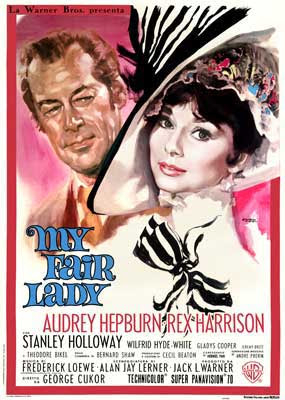Musical films were experiencing something of a comeback in the early 1960s, where filmmakers were choosing expansive sets, period costumes, and an overall far more epic take on the genre than the movie musicals of the 1930s and 40s had done.Along with stunning sets and costumes, was a much longer running time. This film clocks in at nearly three hours and almost every song came with at least two bridges and a long dance sequence. Though beautifully done, this film is not for those with short attention spans! As a result of all this, at the time it was produced, My Fair Lady was Warner Bros. Studios most expensive film to create, costing some seventeen million dollars, but it paid off, with the film being one of the top five of 1964. (Almost) no expense was spared. Watching the film it soon becomes clear that much of the choreography and film work was done to show off the expansive sets as people danced down streets, around corners and into other set pieces in long, flowing sequences. The period costumes too were prolific, with many extras milling in the background. There were a few limits though. When director George Cukor was unhappy with the famous Ascot Race sequence, Jack Warner literally destroyed the set to prevent Cuckor's expensive plan for retakes.
The casting of the film had been highly controversial at the time. Julie Andrews had originated the part of Eliza Dolittle on London's West End and New York's Broadway stages, to great acclaim. But studio execs wanted a famous film star in the main role, so went with Audrey Hepburn. This was a bitter disappointment to Andrews, though the two actresses remained friends. Ironically, Julie Andrews was awarded the Best Actress Academy Award that year for her role in Disney's competing film Mary Poppins, and Hepburn failed to receive even a nomination for her part. During Andrew's acceptance speech, she thanked Jack Warner "for making this possible," a subtle dig that if she had taken the role of Eliza for the film, she would have been unable to play the world's most famous nanny. Hepburn herself ended up being less than satisfied with role, as she was dubbed for almost all the songs. She had even walked out of the set in protest for a day- but returned the next politely asking forgiveness for her "wicked behavior." Still, she vowed that she would never do another musical, unless she could sing the songs herself. Rex Harrison, who played the second lead, Professor Higgins in both the stage and movie version, fared slightly better. He too had nearly been rejected for the role for the film, as movie moguls thought he looked too old. Luckily, Harrison sending more flattering head shots changed the execs' minds. Harrison too was not a strong singer; luckily Learner and Lowe, the two-man team behind the musical book of the play, had known this and created Higgins' songs so that he could talk through the lyrics. In fact, Harrison won the Oscar for Best Actor that year, and My Fair Lady also took home Best Picture, and Best Director (George Cukor's only Oscar in his fifty-year career).
 In My Fair Lady, a language expert deplore's the quality of English people's ability to speak their own language
correctly, and makes a bet with a colleague that he could turn a rough talking girl into someone welcome in high society by altering her accent. The woman in question, Eliza Dolittle, seizes on the chance for something more out of life, and agrees to be part of the experiment. As the lessons progress, viewers see how she becomes part of the household, how she picks up an admirer, and her own struggles to see where she fits within London's various classes. All this leads to a battle of wills between the self-absorbed Higgins and Eliza's stubborn temper, but the ending is left somewhat vague. In Shaw's original play, Eliza leaves to marry her somewhat foolish admirer, Freddy, and Higgins is meant to be a bit of a stand-in for Shaw, including his sexual orientation. Shaw felt that Eliza leaving showed her independence, and symbolized that she was her own creature, rather than Higgins' creation. The movie is much less clear with all this, leaving some possibility that their might be romantic feelings between the two, or there might be familial ones, or even that the movie's end signals no more than a pause in their battle of wills rather than a true cease-fire.
In My Fair Lady, a language expert deplore's the quality of English people's ability to speak their own language
correctly, and makes a bet with a colleague that he could turn a rough talking girl into someone welcome in high society by altering her accent. The woman in question, Eliza Dolittle, seizes on the chance for something more out of life, and agrees to be part of the experiment. As the lessons progress, viewers see how she becomes part of the household, how she picks up an admirer, and her own struggles to see where she fits within London's various classes. All this leads to a battle of wills between the self-absorbed Higgins and Eliza's stubborn temper, but the ending is left somewhat vague. In Shaw's original play, Eliza leaves to marry her somewhat foolish admirer, Freddy, and Higgins is meant to be a bit of a stand-in for Shaw, including his sexual orientation. Shaw felt that Eliza leaving showed her independence, and symbolized that she was her own creature, rather than Higgins' creation. The movie is much less clear with all this, leaving some possibility that their might be romantic feelings between the two, or there might be familial ones, or even that the movie's end signals no more than a pause in their battle of wills rather than a true cease-fire.
Still, an opening ending allows the audience to decide what the ultimate fate of the characters are, and no matter where Eliza ends up, you can see for yourself that she is My Fair Lady! So roll the tapes and start watching!



Love my fair lady! So classic!
Reply Deletewww.bstylevoyage.blogspot.com
I've never seen this. 3 hours is quite a commitment though!
Reply Deletebisous
Suzanne
Weirdly we watched it all the time as kids. Maybe the internet is shrinking my attention span. Seriously though, you should watch it at least once. The songs are great :D
DeleteI didn't remember it being that long!
DeleteHow interesting that it was made at the same time as Mary Poppins. Love them both!